by amgranger | Mar 18, 2016
“When I was growing up 50 some years ago in West Gadsden County, I had no idea that the people that were a part of my everyday life would someday chart my path for the future.”
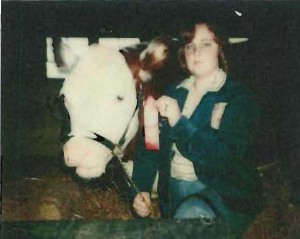
Angel (Clark) Granger showing her steer in Gadsden County, igniting a lifelong passion for 4-H.
I didn’t realize until recently just how deeply my roots are tied to 4-H. Not only does my family represent four generations of 4-H (with the addition of my granddaughter joining this year), but because there were people I took for granted that were absolutely engrained in Extension and 4-H.
I was the first child of Nelson and Karen Clark. I grew up on a farm raising cattle and goats. My grandmother was Ruby Scott Clark and everybody called me “Little Ruby” when I was growing up. She taught me how to string tobacco, garden, ride horses, drive a car, and how to make hoecake. My Granny’s best friend was Miss Elise Lafitte, County Home Demonstration Agent in Gadsden County during the 1950’s. She introduced my aunt, Shirley Clark, a now retired FCS Agent, to my uncle, Scott Clark. My cousin Bernard Clark was an Extension Agent in Gadsden County who is in the Florida 4-H Hall of Fame. My uncle Charles Rowan was an Ag Agent in Dixie and Pinellas Counties. If you read the chapter regarding Gadsden County in the book commemorating the 100 year Anniversary of 4-H in Florida, “Florida 4-H, A century of Youth Success”, you will see my Dad, my sons and me highlighted for our three generations of 4-H participation.
Growing up, I never tried to figure out what Extension was or why we had 4-H, it was just always there. My 4-H Agent growing up was Dickie Bentley. She made monthly visits to Greensboro Elementary School to teach us about record books and 4-H projects. I learned about veterinary science, public speaking, and how to give a demonstration. I still have every ribbon and pin I earned.
I left high school in the eleventh grade to help save the family farm from foreclosure. I soon married my husband Anthony and we moved to Tallahassee to work. In 1985 we bought 10 acres from my Dad, and we moved back home. In 1988 my second child, Cody was born. From the time they were old enough to tote a bucket, my husband and I worked the farm with my dad and taught our sons the value of life on the farm and family traditions.
I have a 4-H Exhibitor Card that was my Dad’s for ears of corn he entered as a 4-H Exhibit, as well as pictures of him showing cattle as a
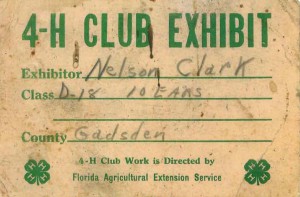
Angel still has her father’s 4-H exhibit card for corn he grew and exhibited at the fair. circa 1956
4-Her. He made sure that I had those same opportunities in 4-H. He bought steers, hogs and feed for me to show as a child, and later also for my oldest son Cole. He and proudly watched Cole work with and show his first steer in 1994.
Sadly, I lost my Dad three months later. He was only 54 and had spent his whole life trying to keep our farm going. I watched my Dad struggle every day, working as a barber, a school bus driver, and a farmer to make ends meet. He bought cheap cattle, made poor decisions regarding crops, nearly lost everything to bankruptcy and soybean disaster, but he never gave up. I vowed the day I buried my Dad that I was going to find a way to help other people like my Dad, I just never dreamed it would lead me into Extension.
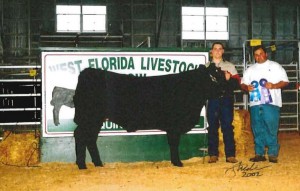
Angel’s sons, Cole and Cody Granger, also grew up in the 4-H family tradition and reply on many of the skills they learned in 4-H in their jobs as civil engineers.
After dad’s death, we continued what he started by keeping the boys in 4-H. I became the livestock club leader. My husband also volunteered to keep our boys active in 4-H showing cattle, hogs, and horses, and competing in county events until they both graduated high school. Both of my sons will tell you that 4-H played a huge role in making them the men they are today. They were part of clubs that had inclusive environments, they had opportunities to meet new people and were both able to use the skills they mastered to be successful in not only their college careers, but as professional engineers today.
After my sons finished high school and started college, I decided it was time to finish my education as well. Both of my sons graduated with degrees in Civil Engineering and I graduated with a degree in Agriculture with Emphasis in Animal Science. I had dreams of
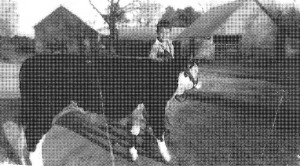
Nelson Clark showing a steer, circa late 1940’s/early 1950s
becoming an Extension Agent and working with farmers and families to help them make good decisions and have access to resources. After two years, I was hired as the 4-H Youth Development Agent in Jackson County (ironically my Granny was born and raised in Bascom, a small town in Jackson County). After a successful 32-year career with the Florida Department of State, I set out on another exciting 4-H journey. Every day I strive to honor the memory of my Dad (who would have been 76 years old this month), my Granny, and my other family members who have been part of the legacy of Extension. Most importantly, I strive to make a difference in a young person’s life just like my 4-H Agent did.
Are you part of a 4-H family tradition? If not, consider starting one today. 4-H offers a broad spectrum of projects and activities to serve a variety of interests, skills, and knowledge. Contact your local UF IFAS Extension office or visit http://florida4h.org to enroll as a youth member or adult volunteer!
by Monica Brinkley | Feb 12, 2016
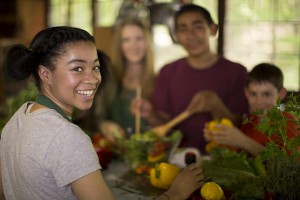
Making family meal time a priority can increase your children’s self esteem.
In a recent book entitled The Surprising Power of Family Meals, author Miriam Weinstein asks this question:
“What if I told you that there was a magic bullet-something that would improve the quality of your daily life, your children’s chances of success in the world, (and) your family’s health…? Something that is inexpensive, simple to produce, and within the reach of pretty much everyone? (Weinstein, 2005, p. 1)”
You guessed it, that magic bullet is the family meal! According to research, eating together as a family on a regular basis has some surprising effects. When sharing a meal together family bonds become stronger, children are better adjusted, family members eat more nutritional meals, they are less likely to be overweight, and they are less likely to abuse alcohol or other drugs. Given the positive benefits of eating together, why are more families not doing it?
It may come as a surprise to you that 71% of older children and teenagers consider talking/catching-up, and spending time with family members as the best part of family dinners. Family meals are a representation of the ethnic, cultural, or religious heritage of the family (Weinstein, 2005). A study found that children who knew a lot about their family history had a closer relationship to family members, higher self-esteem, and a great sense of control over their own lives (Duke, Fivush, Lazarus, & Bohanek, 2003).
With this in mind, why not make shared family meals a priority. Emphasize the importance of being together, not creating an elaborate meal that everyone will enjoy. Set regular meal times by writing them on the calendar. Let everyone know when dinner is served and when they must be home.
If the family is not used to eating together regularly, start small. At first, get used to eating together by scheduling family meals two or three days per week. Then, as the weeks progress, begin to have more and more regular meals.
Make family meals fun. Include children in the preparation of the meal and in the decision about what foods will be offered during the meal. Of course, parents have final say about what foods are prepared, but allowing the children to participate can create a fun environment.
- Keep a sense of humor while at the dinner table.
- Eliminate distractions, like TV, telephone, and cell phones.
- Limit conversations to positive or neutral topics.
- Be a good role model. Show children good etiquette and table manners.
Eating together as a family is more than just a meal, it is an opportunity for families to come together regularly in support of family unity. Although there is no guarantee that eating together as a family will resolve all family problems, it may provide the opportunity to make a fresh start. Do you have a passion for meal preparation or etiquette that you would like to share with the next generation? Consider becoming a 4-H Volunteer! Visit our website or contact your local UF IFAS Extension Office.
For the more information on this topics please visit the EDIA website at http://edis.ifas.ufl.edu, FCS8871.
Source Family Nutrition: The Truth about Family Meals, Larry Forthun
by Heather Kent | Nov 26, 2014
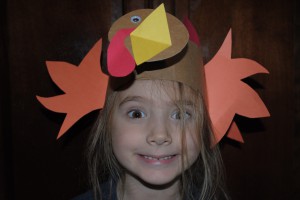 Gratitude is a tricky concept to teach children. It is essential for our happiness, but easily overlooked in the hustle and bustle of our busy everyday lives. With Thanksgiving approaching, it is a great opportunity to do an activity with your kids to help reinforce the concept of gratitude. Here are three simple ideas that you may want to incorporate into your Thanksgiving festivities (or anytime of year):
Gratitude is a tricky concept to teach children. It is essential for our happiness, but easily overlooked in the hustle and bustle of our busy everyday lives. With Thanksgiving approaching, it is a great opportunity to do an activity with your kids to help reinforce the concept of gratitude. Here are three simple ideas that you may want to incorporate into your Thanksgiving festivities (or anytime of year):
Thankfulness Tablecloth– purchase an inexpensive plain tablecloth (a muslin painter’s drop cloth is an inexpensive option). Ask family members to write what they are thankful for with a permanent marker onto the tablecloth. You can assign each family member a different color, or use a different color each year. If your children are not reading age, ask them to draw a picture of what they are thankful for. Add to the tablecloth each year.
What Would It Feel Like Without Game…Ask each member of the family to think of something they are thankful for and then ask them to describe what it would feel like if they didn’t have what they are thankful for. For example, I am thankful for a car that works and it would be hard to take my kids to school, soccer practice, and 4-H club meetings if I didn’t have a car that runs.
Gratitude Time Capsule- Ask each member of the family to write or draw something they are grateful for. Have them date and sign the slip of paper, then place the slips of paper in a mason jar. Have the kids help dig a hole in the yard to bury the jar. Do this each year and then dig up the previous year’s jar to see what has changed.
We hope you will consider adding one of these activities to your Thanksgiving traditions. Gratitude leads to Generosity, which is one of the Essential Elements youth need in order to grow up to be confident, capable citizens. Fostering a sense of generosity is just one way the 4-H volunteers and parents help youth. This time of year, 4-H Agents are especially thankful for the incredible 4-H volunteers who are making a real difference in hundreds of thousands of youths’ lives all across our state. 4-H volunteers are the core of the Florida 4-H Program and we THANK YOU for your service! For more information about 4-H, or becoming a volunteer, contact your local UF IFAS County Extension Office or visit http://florida4h.org.






